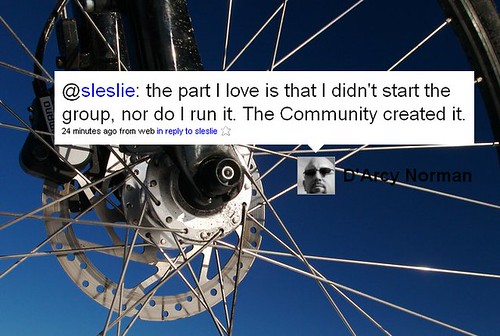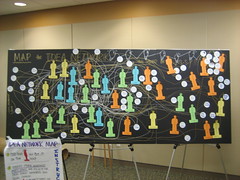D’Arcy Norman, this morning on Twitter. A sure community indicator.
Author: Nancy White
Hopping Between Notetaking and Backchannel Conversations
One of the practices that is part of my daily routine in communities and teams which use phone calls for meetings, is to take notes in a chat environment. I am really good at capturing notes so I’m often one of the note takers. I find typing increases my attentiveness and listening. Otherwise I’m prone to multitasking (email, checking twitter, writing blog posts. Should I admit I started writing this post while on a telecon?)

What I’ve noticed is that I’ve started to use the chat as back channel for voicing my own input and thoughts. This is more like the “backchannel” used by techie communities, particularly during face to face events. It is another layer of conversation that enables more than one person to “talk” at the same time. It is also useful in web meetings. Back channel, of course, has it’s risks too — fractured attention and a channel for mocking etc — but it is different from the note taking practice. One is a record, the other is part of the conversation. One represents the voices of others, the other IS the voices.
When I mix the two, I start wondering, am I compromising the note taking with my comments and input? Or am I adding richness and voice to the proceedings? Am I strengthening the conversation by adding text input and not interrupting, or am I undermining the speaker? All these are possible. So how does this inform my choices in my practice?
This duality reminds me of this “two hatted” feeling I get when I am in a facilitator role. I often feel I am not fully devoting myself to facilitation if I put my participant hat on. When I do, I do it explicitly. I am wondering, should I do that when I shift in chat, or does that just add more noise to a fast flowing chat?
What do you think?
Photo by Salvor
Visualizing Your Social Network
I have done informal network mapping exercises and have often struggled with a medium for the line. Voila, look at this great picture from Eugene Eric Kim – cut outs that you put your name on and then it looks like a black-board like surface you can draw lines with chalk.
The network mapping exercises I have done recently have asked people to map their collaborative or project networks. At first everyone sort of grumbles, they think everything is obvious. Then they start seeing new things. Patterns. They compare with others’ maps and begin to think more strategically about their own network.
The power of the visual plus conversation!
Yes We Can – the role of emotion in system change
I tend to avoid political commentary in my blog. (Lots of reasons – I’ll not bother you with that at the moment.) But today I was pointed to a video about Barack Obama’s US presidential campaign that appears right now on Dipdive.com that is worth sharing. Oddly, it is not (yet?) embeddable video. It should be. (The http://www.yeswecan.com website itself is down for me a the moment.)
EDIT: 9:09 AM – here is the embeddable YouTube Version
What this video does is emotional motivation. It uses words and music – two very emotionally rich media – to convey a simple point of hope. The emotional state it can engender – if it resonates with you – prepares you for taking action.
When we think about facilitating change, we often focus on our logic. Our goals. Our tactics. What this video reminds me that we also need to attend to the emotional and emotive context of our change methods and plans. Read the note of will.i.am (of the Black Eyed Peas) the creator of the video, just below the video (also here on his blog). Read about why and how he acted. Who acted with him.
I think one reason I have been so captivated lately by graphic recording and facilitation is that images carry more than “the facts.” They trigger more than the logical and important “next step.” So does the music in this video.
will.i.am, thanks for the reminder. Yes, we can.
And, on a side note. I sense this video could be a sea change for the Obama campaign. “We are not divided as our politics suggests.” Oh, I hope so, regardless of the outcome.
yes, we can
What should be in my blog feed?
When I transitioned from Blogger to WordPress for my blog, I had a fresh chance to look at my RSS feed options. On blogger, I had a ton of buttons for people to choose different options. At the time, people NEEDED more options. Now services like Feedburner help consolidate options into one service.
In the transition, I could redirect my Feedburner burn to my new blog page (new url!) and hopefully those of you following via FB had uninterrupted service. But what about everyone else? Some of the other RSS methods were confined to the old URL, so I just posted a post on my old blog asking people to resubscribe to the new one. I suspect I lost a lot of subscribers.
In many ways, this is just like cleaning out old email addresses that people don’t use anymore. I suspect many of those subscribers no longer followed the blog, so it was good house cleaning. But I’ve heard from a few people that they just lost me off their radar screen. I haven’t quite figured out what to do about that.
In all this review of feeds, I also played with my Feedburner feed which allows you to include things like your del.icio.us tags and Flickr photos. I wondered if you, dear readers, found those helpful or not. Last night I got some feedback that the photos were not so great – not that the person didn’t like my photos, but in the context of expecting blog posts, they felt out of place. I tend to agree.
Then I thought, I should ask you. What do you like in the feed? What would you prefer taken out? If there is a strong consensus, I’ll plan accordingly. If no one cares, I’ll pull out the photos for now and see if that “feels” better!
